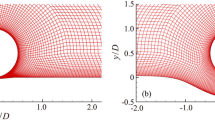Abstract
This paper presents the results from laboratory experiments and theoretical analysis to investigate the development of scour around submarine pipeline under steady current conditions. Experiments show that the scour process takes place in two stages: the initial rapid scour and the subsequent gradual scour development stage. An empirical formula for calculating the equilibrium scour depth (the maximum scour depth) is developed by using the regression method. This formula together with the maximum entropy theory can be applied to establish a formula to predict the scour process for given water depth, diameter of pipeline and flow velocity. Good agreement between the predicted and measured scour depth is obtained.
Similar content being viewed by others
References
Azamathulla, H. M., Yusoff, M. A. M., and Hazen, Z. A., 2013. Soft computing for prediction of river pipeline scour depth. Neural Computing and Applications, 23: 2465–2469.
Azamathulla, H. M., Yusoff, M. A. M., and Hazen, Z. A., 2014. Scour below submerged skewed pipeline. Journal of Hydrology, 509 (2): 615–620.
Bakhtiary, Y. A., Kazeminezhad, H. M., Shahide, E. A., Baas, J., and Cheng, L., 2011. Euler-Euler two-phase flow simulation of tunnel erosion beneath marine pipelines. Applied Ocean Research, 33 (2): 137–146.
Brors, B., 1999. Numerical modeling of flow and scour at pipelines. Journal of Hydraulic Engineering, 125 (5): 511–523.
Cheng, L., Kervin, Y., Zhang, Z. P., and Teng, B., 2009. Threedimensional scour below offshore pipelines in steady currents. Coastal Engineering, 56 (5): 557–590.
Chiew, Y. M., 1991. Prediction of maximum scour depth at submarine pipelines. Journal of Hydraulic Engineering, 117 (4): 452–466.
Chiu, C. L., Nordin, C. F., and Hu, W. D., 1983. A method for mathematical modeling and computation of hydraulic processes in river bends. In: Proceedings of Rivers '83, a Specialty Conference on River Meandering. Sponsored by the Waterway, Port, Coastal and Ocean Division of ASCE, New Orleans, 24–26.
Chiu, C. L., 1986. Structure of 3D flow in rectangular open channels. Journal of Hydraulic Engineering, 112: 1051–1067.
Chiu, C. L., 1989. Velocity distribution in open channel flow. Journal of Hydraulic Engineering, 115: 576–594.
Chiu, C. L., 1991. Application of entropy concept in openchannel flow study. Journal of Hydraulic Engineering, 117: 615–628.
Chiu, C. L., 1995. Maximum and mean velocities and entropy in open-channel flow. Journal of Hydraulic Engineering, 121 (1): 26–35.
Chiu, C. L., Chen, Y. C., 2003. An efficient method of discharge estimation based on probability concept. Journal of Hydraulic Research, 41 (6): 589–596.
Chiu, C. L., and Lin, G. F., 1983. Computation of 3D flow and shear in open channels. Journal of Hydraulic Engineering, 109 (11): 1424–1440.
Cui, H. J., and Singh, V. P., 2013. Two-Dimensional velocity distribution in open channels using the Tsallis entropy. Journal of Hydraulic Engineering, 18 (3): 331–339.
Cui, H. J., and Singh, V. P., 2014. Computation of suspended sediment discharge in open channels by combining Tsallis entropy-based methods and empirical formulas. Journal of Hydraulic Engineering, 19 (1): 18–25.
Dey, S., and Singh, N. P., 2008. Clear-water scour below underwater pipelines under steady flow. Journal of Hydraulic Engineering, 134 (5): 588–600.
Dong, S., Wang, N. N., Liu, W., and Guedes, S., 2013. Bivariate maximum entropy distribution of significant wave height and peak period. Ocean Engineering, 59 (1): 86–99.
Fredsøe, J., Sumer, B. M., and Arnskov, M. M., 1992. Time scale for wave/current below pipelines. International Journal of Offshore and Polar Engineering, 2 (1): 301–307.
Hong, J. H., Kumar, G. M., Chiew, Y. M., and Chua, L. H. C., 2012. Predicting time-dependent pier scour depth with support vector regression. Journal of Hydrology, 468-469 (22): 241–248.
Liang, D. F., Cheng, L., and Li, F. J., 2003. Numerical modeling of flow and scour below a pipeline in currents PART2. Scour simulation. Coastal Engineering, 52 (1): 43–62.
Moncada, M. A. T., and Aguirre, P. J., 1999. Scour below pipeline in river crossings. Journal of Hydraulic Engineering, 126 (10): 953–958.
Shannon, C. E., 1948. A mathematical theory of communication. Computing and Communication Review, 5 (1): 3–55.
Yang, L. P., Guo, Y. K., Shi, B., Kuang, C. P., Xu, W. L., and Cao, S., 2012. Study of scour around submarine pipeline with a rubber plate or rigid spoiler in wave conditions. ASCE Journal of Waterway, Port, Coastal and Ocean Engineering, 138 (6): 484–490.
Yasa, R., and Shahidi, E. A., 2014. Classification and regression trees approach for predicting current-induced scour depth under pipelines, Journal of Offshore Mechanics and Arctic Engineering, 136 (1): 1–8.
Zhao, Z. H., and Fernando, H. J. S., 2007. Numerical simulation of scour around pipelines using an Euler-Euler coupled twophase model. Environment Fluid Mechanics, 7 (2): 121–142.
Author information
Authors and Affiliations
Corresponding author
Rights and permissions
About this article
Cite this article
Zhang, J., Shi, B., Guo, Y. et al. Scour development around submarine pipelines due to current based on the maximum entropy theory. J. Ocean Univ. China 15, 841–846 (2016). https://doi.org/10.1007/s11802-016-3065-y
Received:
Revised:
Accepted:
Published:
Issue Date:
DOI: https://doi.org/10.1007/s11802-016-3065-y



